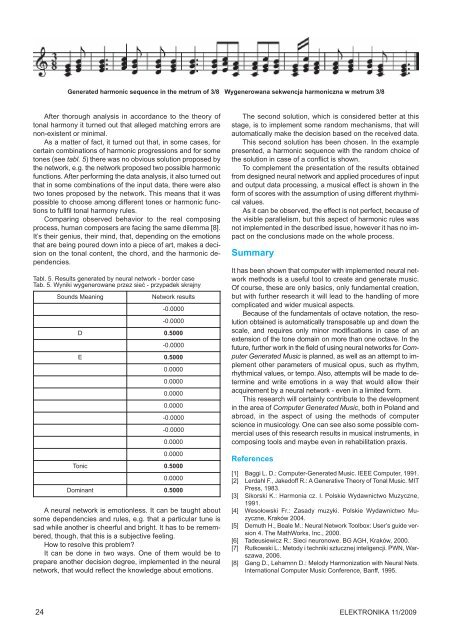Elektronika 2009-11.pdf - Instytut Systemów Elektronicznych
Elektronika 2009-11.pdf - Instytut Systemów Elektronicznych
Elektronika 2009-11.pdf - Instytut Systemów Elektronicznych
You also want an ePaper? Increase the reach of your titles
YUMPU automatically turns print PDFs into web optimized ePapers that Google loves.
Generated harmonic sequence in the metrum of 3/8 Wygenerowana sekwencja harmoniczna w metrum 3/8<br />
After thorough analysis in accordance to the theory of<br />
tonal harmony it turned out that alleged matching errors are<br />
non-existent or minimal.<br />
As a matter of fact, it turned out that, in some cases, for<br />
certain combinations of harmonic progressions and for some<br />
tones (see tabl. 5) there was no obvious solution proposed by<br />
the network, e.g. the network proposed two possible harmonic<br />
functions. After performing the data analysis, it also turned out<br />
that in some combinations of the input data, there were also<br />
two tones proposed by the network. This means that it was<br />
possible to choose among different tones or harmonic functions<br />
to fullfil tonal harmony rules.<br />
Comparing observed behavior to the real composing<br />
process, human composers are facing the same dilemma [8].<br />
It’s their genius, their mind, that, depending on the emotions<br />
that are being poured down into a piece of art, makes a decision<br />
on the tonal content, the chord, and the harmonic dependencies.<br />
Tabl. 5. Results generated by neural network - border case<br />
Tab. 5. Wyniki wygenerowane przez sieć - przypadek skrajny<br />
Sounds Meaning<br />
Network results<br />
-0.0000<br />
-0.0000<br />
D 0.5000<br />
-0.0000<br />
E 0.5000<br />
0.0000<br />
0.0000<br />
0.0000<br />
0.0000<br />
-0.0000<br />
-0.0000<br />
0.0000<br />
0.0000<br />
Tonic 0.5000<br />
0.0000<br />
Dominant 0.5000<br />
A neural network is emotionless. It can be taught about<br />
some dependencies and rules, e.g. that a particular tune is<br />
sad while another is cheerful and bright. It has to be remembered,<br />
though, that this is a subjective feeling.<br />
How to resolve this problem?<br />
It can be done in two ways. One of them would be to<br />
prepare another decision degree, implemented in the neural<br />
network, that would reflect the knowledge about emotions.<br />
The second solution, which is considered better at this<br />
stage, is to implement some random mechanisms, that will<br />
automatically make the decision based on the received data.<br />
This second solution has been chosen. In the example<br />
presented, a harmonic sequence with the random choice of<br />
the solution in case of a conflict is shown.<br />
To complement the presentation of the results obtained<br />
from designed neural network and applied procedures of input<br />
and output data processing, a musical effect is shown in the<br />
form of scores with the assumption of using different rhythmical<br />
values.<br />
As it can be observed, the effect is not perfect, because of<br />
the visible parallelism, but this aspect of harmonic rules was<br />
not implemented in the described issue, however it has no impact<br />
on the conclusions made on the whole process.<br />
Summary<br />
It has been shown that computer with implemented neural network<br />
methods is a useful tool to create and generate music.<br />
Of course, these are only basics, only fundamental creation,<br />
but with further research it will lead to the handling of more<br />
complicated and wider musical aspects.<br />
Because of the fundamentals of octave notation, the resolution<br />
obtained is automatically transposable up and down the<br />
scale, and requires only minor modifications in case of an<br />
extension of the tone domain on more than one octave. In the<br />
future, further work in the field of using neural networks for Computer<br />
Generated Music is planned, as well as an attempt to implement<br />
other parameters of musical opus, such as rhythm,<br />
rhythmical values, or tempo. Also, attempts will be made to determine<br />
and write emotions in a way that would allow their<br />
acquirement by a neural network - even in a limited form.<br />
This research will certainly contribute to the development<br />
in the area of Computer Generated Music, both in Poland and<br />
abroad, in the aspect of using the methods of computer<br />
science in musicology. One can see also some possible commercial<br />
uses of this research results in musical instruments, in<br />
composing tools and maybe even in rehabilitation praxis.<br />
References<br />
[1] Baggi L. D.: Computer-Generated Music. IEEE Computer, 1991.<br />
[2] Lerdahl F., Jakedoff R.: A Generative Theory of Tonal Music. MIT<br />
Press, 1983.<br />
[3] Sikorski K.: Harmonia cz. I. Polskie Wydawnictwo Muzyczne,<br />
1991.<br />
[4] Wesołowski Fr.: Zasady muzyki. Polskie Wydawnictwo Muzyczne,<br />
Kraków 2004.<br />
[5] Demuth H., Beale M.: Neural Network Toolbox: User’s guide version<br />
4. The MathWorks, Inc., 2000.<br />
[6] Tadeusiewicz R.: Sieci neuronowe. BG AGH, Kraków, 2000.<br />
[7] Rutkowski L.: Metody i techniki sztucznej inteligencji. PWN, Warszawa,<br />
2006.<br />
[8] Gang D., Lehamnn D.: Melody Harmonization with Neural Nets.<br />
International Computer Music Conference, Banff, 1995.<br />
24 ELEKTRONIKA 11/<strong>2009</strong>

















